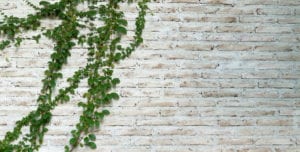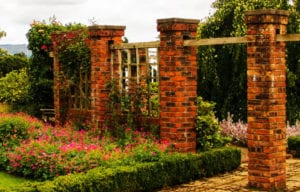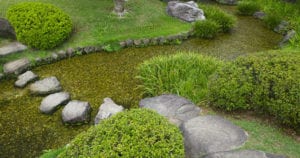
Walls and fences are an important part of any garden and when done correctly provide both shelter and instant impact. In smaller gardens, they tend to be the most dominant element, especially in winter when there’s little else to distract the eye that’s why it is essential to ensure that they are not merely functional but ascetic features.
Seven reasons why walls and fences are important.
- They mark the extent of your property.
- They provide privacy
- They provide some shelter from the elements.
- They provide some shade
- They can create warmer microclimates which extend planting options
- They provide an excellent backdrop to planting schemes
- They can hide or mask an unattractive view.
Walls and Fences don’t have to be bland and densely planted ones can blur the boundaries of a garden so that neighbouring items may appear to be part of the Scene. In Japan, this is known as “Shakkei” borrowed scenery. They can also be spruced up to suit their location too; however, it is best done in keeping with the surroundings.
Country gardens lend themselves towards informal boundaries such as mixed hedges, ideally thorny ones to make them more secure or stone walls. Small front gardens can also look good with low picket fences.
City gardens really need to reflect the built environment they are in here the best options tend to be brick walls (in keeping with the style of the property, smooth planed wooden fences or cast-iron railings. Clipped formal hedges can also look good.
Suburban gardens need a style somewhere between the two and the surrounding properties can serve as a guide.

supawat bursuk/Shutterstock
Internal boundaries.
Walls and fences are not limited to marking the outer bounds of your territory and whatever the size of your garden internal divisions they are useful as they not only serve to split up the garden, so offering subtle elements of surprise and mystery, but internal screens can also serve to hide the less attractive elements such as the tool shed, compost heap or dustbin store.
Internal screens also allow you to have different zones and styles – even in a relatively small space. Given there is less concern about privacy and security with internal boundaries you can use things such as willow withies to make a simple barrier. Alternatively, groups of shrubs can be used or in a small garden, even one large specimen plant can do the job. If you really want to get creative, a section of freestanding wall or fence can look quite dramatic, while offering eye-catching sculptural elements.

TreasureGalore/Shutterstock
Internal screens or separators don’t necessarily have to be vertical and a change of level such as a raised bed can also mark a change in space. If your garden is large enough a water crossing such as a small stream or rill with a bridge or stepping stones can also make a super effective divide.

sirtravelalot/Shutterstock
Working With Colours
Walls and fences whether boundary or internal don’t have to be boring and the clever use of colour and or texture can dramatically change the look. You can, of course, leave the outward facing parts neutral if you don’t want to upset the neighbours. When it comes to choosing colours consider the style of your garden carefully. Soft pastels – blues, greens & lavenders look great in traditional country style gardens; while crisp neutrals – greys, beiges & taupe’s work well in more formal settings. For the contemporary look think stronger shades such as ochre, terracotta and even plum.
In warm southern climates white can be a good choice, however, it tends to be too harsh for more northern regions, especially during the drab winter months. Here if a lighter palette is desired cream’s & soft yellows are a lighter option while still having some warmth. While we are about colours it’s important to remember that colour affects people’s moods and thus will also affect the way an onlooker perceives the garden. Hot colours, be it paint or plant such as red and orange are stimulating and energising, these will tend to make a garden look smaller. Cool colours such as blues and mauves are more relaxing and will make any space look bigger. It’s also worth bearing in mind how any colour will work as a backdrop for plants, soft blues and greens tend to work well with most things, while stronger tones can add a dramatic effect to a hot colour planting scheme.
Finally adding a few finishing touches to a wall or fence can really add interest, hanging items on a wall really draws the eye while adding finials such as balls, or pyramids can turn fenceposts into architectural features in their own right.
Thank you Tuppence for this informative article.